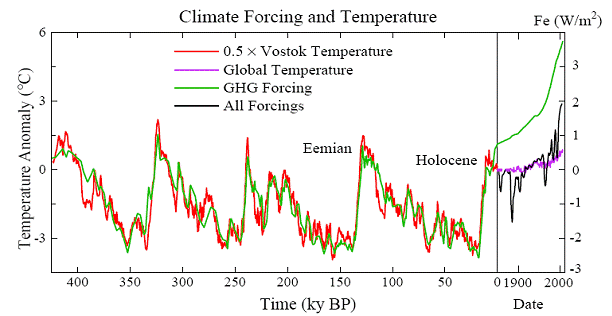The mothballing of Australia’s CPRS, a scheme at best symbolic in nature, heralds the success of the massive anti-climate science disinformation campaign waged on the pages of the conservative media. Other sections of the media, including the ABC, maintain a “balance”. Where 2+2=4, and if the party in George Orwell’s 1984 decrees “2+2=5”, the media’s “balanced” approach suggests “2+2=4.5”
Day-in and day-out the media trots rising and falling interest rates, the All-Ord index, GDP growth percentages and footy scores, failing to report the atmospheric CO2 growth rate on which future global temperatures depend, last recorded as 391 ppm (parts per million) at Mouna Loa and rising at a rate of about 2.02 ppm per-year (2009).
The shelving of the CPRS represents the stark difference between those who call for 11th hour attempts to stem the unfolding climate catastrophe and those who propose to continue in business as usual. Unfortunately the atmosphere is not waiting for human decision. Summing up the implications of the current collapse of the great ice sheets, rise of sea level, migration of climate zones toward the poles and intensification of extreme weather events, a joint communiqué by the world’s academies of science states:
However, climate change is happening even faster than previously estimated; global CO2 emissions since 2000 have been higher than even the highest predictions, Arctic sea ice has been melting at rates much faster than predicted, and the rise in the sea level has become more rapid. Feedbacks in the climate system might lead to much more rapid climate changes.
Evidenced by accelerating ice melt rates, as reported by NASA,
The most detailed satellite information available shows that ice sheets in Greenland and western Antarctica are shrinking and in some places are already in runaway melt mode. A new study, using 50 million laser readings from a NASA satellite, calculates changes in the height of the vulnerable but massive ice sheets and found them especially worse at their edges, where warmer water eats away from below. In some parts of Antarctica, ice sheets have been losing 30 feet a year in thickness since 2003.
As reported recently by the Australian CSIRO and BOM:
“Australia will be hotter in coming decades. Australian average temperatures are projected to rise by 0.6 to 1.5 ºC by 2030. If global greenhouse gas emissions continue to grow at rates consistent with past trends, warming is projected to be in the range of 2.2 to 5.0º C by 2070” and “Much of Australia will be drier in coming decades.”
Lost on people and governments is the reality of a world with “2.2 to 5.0º C by 2070,” a development which exceeds the glacial-interglacial climates (Figure 1) and climate conditions since 2.8 million years ago, signifying an environmental calamity which defies contemplation, where our children will need to survive, including:
Accentuation of current trends, where much of southern, southwestern and southeastern Australia will become prone to cycles of increasingly severe droughts and bushfires, while the north and corridors in west-central and eastern Australia suffer floods.
At mean global temperatures above 2º C a large part of the Greenland and west Antarctica ice sheets would melt, leading to sea level rise on the scale of many meters.
The loss of regular Himalayan snow-fed river flow in southern and southeast Asia, replaced by low river levels and intermittent floods which, when combined with sea level rise, inundate river delta and low river valleys (Yangtze, Yellow River, Mekong, Ganges, Brahmaputra, Indus), which can only result in hundreds of millions of refugees.
As one of the world’s top per-capita emitters, as well as major exporter of coal, Australia bears responsibility. Ironically the current stream of coal export ships may lead to a future influx of refugee boats compared to which the current influx would pale into insignificance.
By 2012, when the CPRS may, or may not, be resurrected from the mothballs, CO2 levels would have risen by about 6 parts per million, edging toward 400 ppm, or 460 ppm CO2-equivalent (including methane), which approaches the upper stability limits of the Greenland and Antarctic ice sheets.
“We’re simply talking about the very life support system of this planet.”
(Joachim Schellnhuber, Director, Potsdam Climate Impacts Institute, advisor to the German government).











